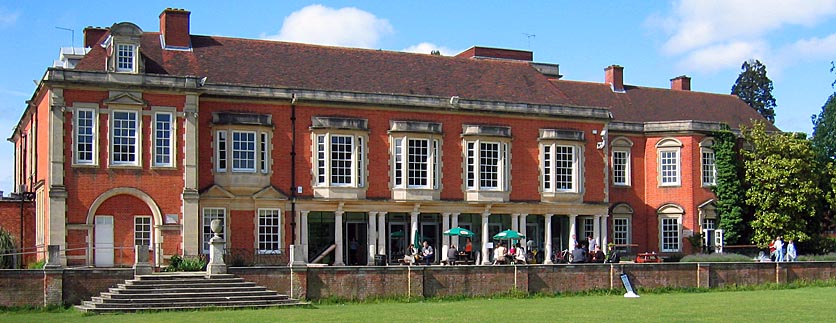 |
 |
|||
|
|

South
Hill Park South Hill Park is an elegant red-brick mansion, mostly of the Victorian period. It stands within fine gardens and the remnants of its original 800 acre park which still features two good lakes, situate at Birch Hill in Bracknell. The first house on the site was built in 1760 for a retired senior official in Government of Bengal named William Watts. His architect constructed a fashionable two storey brick Italianate building decorated with stucco and a Baroque tower. Watts enclosed some 30 acres of common land to add to the park he was creating and found himself obliged to erect a set of almshouse near Easthampstead Church as a form of compensation to the locals. Unfortunately, he died only four years later, and the house began its journey through a number of new owners. The Hon. Henry Bouverie was there until 1787, then Sir Stephen Lushington and George Canning, who acquired the property in about 1801. In this same year, he engaged Sir John Soane to make alterations at the house in preparation for the arrival of his new bride. Canning was a Great Statesman, being Secretary of State for Foreign Affairs under William Pitt and Foreign Secretary under Lord Portland. In 1809, he was famously wounded in the thigh during a duel with the Minister for War, Lord Castlereagh, after an argument concerning troop movements against Napoleon. But he had sold South Hill Park the previous year and the house did not see its one time owner appointed as Prime Minister in 1827. The Earls of Limerick were the next owners of the Park, followed by Sir James Matheson. In 1853, he sold the estate to the Judge Advocate General, Sir William Goodenough Hayter. His busy political career had left him somewhat depressed and he was found drowned in the lake at South Hill Park in 1878. Towards the end of the century, his son, Sir Arthur Divett Hayter, rebuilt most of the house following a disastrous fire. Under the direction of Temple Moore, the building we see today was erected in local Lawrence brick and Bath stone. The east wing of the original house was, however, retained within the new structure. The Hayter Coat of Arms, featuring three golden bulls' heads and a scallop shell can thus be seen over the main entrance. William Gladstone visited the Hayters at South Hill Park in 1893 and a plaque in the grounds records that he planted an oak tree there. Sir Arthur was in inherited the Haversham Barony in 1906, but he had no direct heirs and, in 1929, the house passed to his wife's nephew, a Major Rickman. This man is best known for shooting himself in the Gun Room in 1940. During the Second World War, South Hill Park was occupied by the Royal Sea Bathing Hospital, which had been evacuated from Margate. After the War, it was divided into flats, but was purchased by the BBC in 1953 and parts were converted into studios and acoustically treated rooms. In 1963, the Bracknell Development Corporation acquired the house as part of an extension of the new town's designated coverage. They let South Hill Park to Ferranti in 1965 and it was used as laboratories and offices until early 1972 when proposals for its conversion to an Arts Centre and theatre were agreed. The house is now one of the largest and diverse arts facilities in the country. It also has a secondary reputation as one of the most haunted houses in Berkshire. South Hill Park is now an Arts Centre run by Bracknell Forest Borough Council.
|
|||
| © Nash Ford Publishing 2004. All Rights Reserved. | ||||


